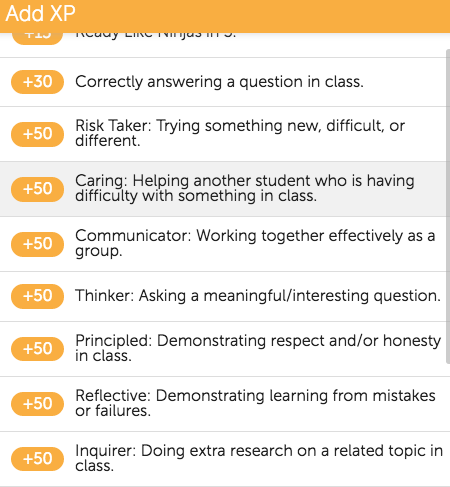Clik here to view.

Guest post contributed by Classcraft Ambassador Lukas Gohl
This year, my school began its implementation of the International Baccalaureate’s (IB) Middle Years Programme. While many of the instructional approaches of the IB dovetail with our school’s current practice, my main challenge has been how to bring its cross-curricular models, the Learner Profile (LP) and Approaches to Learning (ATL), into my classroom in a way that’s both concrete and meaningful for students.
Classcraft’s customizable Experience Points (XP) and Gold Pieces (GP) settings have been extremely helpful to this end. For any teacher in a school, IB or otherwise, Classcraft is an excellent tool to help inculcate these types of social and executive functioning skills.
The IB’s LP consists of a series of attributes for well-rounded students, such as “caring, open-minded, inquirer, courageous,” and so forth. At the beginning of the year, my students and I discussed both the Learner Profile as well as our essential agreements, eventually creating Classcraft descriptors that positively exemplify the LP in our classroom:
Clik here to view.

While the LP focuses more on affective attributes, the ATLs are general academic skills that every learner should possess and develop across the curriculum. Along with our preset Learner Profile settings, I also invite students to create criteria for demonstrating ATLs throughout a unit or a formative activity.
For example, prior to a peer feedback session on a writing project, I show students relevant target ATLs, such as “give and receive meaningful feedback.” I then ask them to work in small groups to generate criteria by prompting, “What does it look like to give and receive meaningful feedback?” Through a little discussion and teacher guidance, we create a set of “power moves” that will unlock XP or GP for that student. Some power moves we’ve used in the past for this ATL are 1) provide both a positive comment and a constructive comment, and 2) use language from our rubric in your feedback.
During class, as students are giving each other feedback, I can either walk around the room to give coaching and award XP/GP — or, if I don’t want to interrupt, I can monitor student’s Google Docs. Conversely, this activity can also serve as formative feedback if the ATLs are being explicitly taught as part of a lesson. While these types of activities can be done without Classcraft, what it provides is a platform for making student progress toward these outcomes clear and visible. This is crucial for self-monitoring and helping students “own” these skills and dispositions independently
In the end, my goal with Classcraft is always to emphasize opportunities for autonomy, mastery, and purpose — not XP grubbing. This is why I focus on Classcraft as a tool for success in learning, not the other way around. As one of my students aptly puts it, “Classcraft is like a cast. It gives us the support we need to do something until we can eventually do it on our own.”
Lukas Gohl is a Secondary English teacher at Oberoi International School in Mumbai, India. He is currently piloting Classcraft with his two sections of 6th grade students. In his free time, he enjoys writing, the outdoors, and sampling India’s street food.
Twitter: @lukasgohl
Photo credit: altanaka / Shutterstock.com
